Perhaps, a serious fear for every parent is the illness of his child. But as practice shows, it is absolutely impossible to completely avoid them. Even completely healthy, hardened children with good immunity get sick from time to time. And every parent should know how to behave at the first manifestations of the disease.
If we talk about the most common ailment - a cold, then at first it makes itself felt with a slight increase in temperature and redness of the throat. With timely measures taken, you may well be able to cope with these phenomena and prevent further development of the disease. Let's talk today about the symptoms of the disease, when the throat is red, the child has a temperature, what kind of treatment is needed, folk remedies to normalize health.
Temperature
So, if you notice that your child has a fever, and the neck is noticeably colored red, do not panic. If the thermometer readings do not exceed 38.5C, then there is no need to stuff the baby with antipyretic drugs. An increase in body temperature indicates that the immune system is actively fighting the disease, and drugs that lower the temperature can only prevent it.
At elevated temperatures, the child should be in a fairly cool room - be sure to ventilate the room and carry out regular wet cleaning. In order to maintain normal air humidity (about 50%), it is best to use a special humidifier, but the method of our mothers and grandmothers can also be used - just scatter wet towels around the house and put containers with water.
At elevated temperatures, the baby must be given water - babies should be applied to the breast at first request, or even more often, and older children are constantly offered water, weak tea, compote. You should not give the baby soda, also diaphoretic teas (linden, raspberries) will not be the best option, since they will only increase the loss of fluid in the body.
Do not use the old methods of our grandmothers - wipe the patient with vinegar or vodka solution.
First, such measures can cause poisoning with vapors of vinegar or alcohol.
Secondly, (this also applies to ordinary water) they can cause vasospasm, which will only worsen the baby's condition.
If the temperature rises above 38.5C or if the child feels too bad, call a doctor immediately and give him an antipyretic. These can be suppositories or special suspensions containing paracetamol or ibuprofen. It is also imperative to consult a doctor if an infant has a fever.
Red throat - folk remedies
Gargling is ideal for fighting a reddened throat. It is quite possible to teach this simple lesson to a child who has reached one and a half years. A solution made of soda and salt is highly effective. Dissolve a teaspoon of these substances in a glass of water and add a drop of iodine.
Brew a teaspoon of chamomile with a glass of boiling water, soak the product in a water bath for ten minutes, then strain. Use for rinsing five times a day. In the same way, you can brew other herbs - eucalyptus, calendula, sage, coltsfoot.
For maximum efficiency, rinsing should be repeated at half hour intervals.
Take warm water and dissolve a small amount of propolis tincture in it. Such a solution is also great for rinsing, but you should not use it in relation to children that are three years old due to the high allergenicity.
During the treatment of the throat, the baby needs to be especially careful with oral hygiene. Now you need to brush your teeth not twice a day, but after each meal, since food leftovers are an ideal place for microbes to multiply.
Let your child drink decoctions based on cranberry berries and lingonberries, drinks made from rose hips are also highly effective. If the age of the crumbs has exceeded three years, add honey to this drink, which effectively treats colds.
Also, warm milk will be another useful drink, and to soften a sore throat, you can add a little soda to it - a little less than half a teaspoon.
Boil potatoes in their skins, mash them a little with a fork and arrange steam baths over them. Cover the patient's head with a towel - let him breathe over the generated steam. In this case, care must be taken to ensure that the steam temperature is not too high in order to prevent burns.
Sore throat can be oiled with sea buckthorn, rosehip or eucalyptus oil. But keep in mind that they are highly allergenic, so they are not suitable for preschool children. Perform the procedure shortly before meals using a cotton swab.
Pharmacy treatment
Various aerosols can be used to treat red throat, which have antibacterial and antiseptic effects. For younger children, a spray of Chlorophyllipt will be an excellent option, and for older children, you can spray such a composition as Orasept.
Before using medicinal formulations, you need to consult a doctor.
If the child completely refuses to gargle, carry out this procedure in a playful way. Compete, who can rinse longer, promise a cartoon for every second rinse, etc. You can also replace the rinsing a little with special candies with antiseptic agents, but you cannot give them to small children, as they can easily choke.
In the event that the measures taken do not help, be sure to contact medical help.
A high temperature in a child always knocks parents out of the usual rhythm of life and concern for the baby comes to the fore. But if such a symptom as a red throat is added to it, then all together this prompts thoughts about angina, the complications after which are very difficult.
What to do if a child has a red throat and a temperature of 39-40 ° C?
The situation becomes critical when the numbers on the thermometer are approaching forty. Depending on the time of day, you should definitely call a local doctor or an ambulance that may offer hospitalization.
It is advisable, when the child has a very red throat and high fever, to take a blood test and bacterial culture from the throat. In this case, the information obtained will become the basis for the appointment of the correct treatment. The fact is that in such a situation, antibiotic therapy is often immediately prescribed, without knowing whether it is needed or is simply pointless.
SARS, in which a child has a red throat and a high temperature, is treated with various means, including folk remedies, but without the use of an antibiotic, since this disease is caused by viruses that do not respond to antibacterial treatment.
An antibiotic is needed only when a bacterial infection is found in the body, for example, streptococcus or staphylococcus. But for 100 cases of the disease, only 20 are complicated by bacteria, and all the rest are viral.
Treatment with medicinesGargling is the best way to relieve redness in the throat and pain when swallowing. It can be Chlorophyllipt oil and alcohol (mixed in equal amounts), and for older children, a saline solution with a drop of iodine.
In addition, treating inflamed tonsils in the presence of plaque should be done with the same Chlorophyllipt or Lugol - an unpleasant procedure, but very effective. It is possible to irrigate the inflamed throat with the preparations Orasept, Chlorophyllipt, and also give the tablets Septifril, Efizol or Lisobakt to dissolve.
Antipyretic drugs, which should be in every first-aid kit - Paracetamol or Ibuprofen in the form of suppositories or suspension, will help to remove the high temperature. In addition to lowering body temperature, these drugs have an analgesic effect, so that the neck will also become easier.
Folk remedies if the child has a red throat and fever
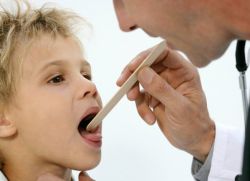 Here, all the same rinses will come to the rescue, but with soda, chamomile, sage and calendula. You can use all of them in turn, or choose just a few. It is important that rinses are frequent - literally every hour or two, then the effectiveness of them will be evident.
Here, all the same rinses will come to the rescue, but with soda, chamomile, sage and calendula. You can use all of them in turn, or choose just a few. It is important that rinses are frequent - literally every hour or two, then the effectiveness of them will be evident.
But inhalation at a temperature is absolutely impossible to do, as well as mustard plasters, compresses and foot baths. So the treatment of such a nuisance consists only in processing the neck, taking painkillers and relieving inflammation. If within 5 days the temperature does not subside, the doctor changes the treatment regimen and prescribes repeated tests.
The most common colds, which are characterized by redness of the larynx. A red throat in a child can talk about various diseases that can be cured at home or exclusively in stationary conditions.
Causes of the problem
- viral infections - spreading the cause of the disease in the child. Symptoms - soreness when swallowing and high fever, from 39 degrees;
- colds... A common cold can cause symptoms such as a red throat in a child and be accompanied by a “barking” and “dry” cough;
- measles. Symptoms - temperature over 39 degrees, points like rashes;
- streptococcal bacteria lead to throat irritation and reddening of the back of the throat. Streptococcus is accompanied by nasal discharge. Treatment requires the use of antibiotics;
- coxsackie viruses lead to diseases of the larynx in infants and preschool children in rare cases, but are accompanied not only by pain in oral cavity, but also rashes on the cheeks and lips or stomatitis;
- angina. With angina, red dots appear on the tonsils and a temperature of more than 39 degrees is characteristic;
- allergy. In rare cases, red spots in the throat may appear due to an allergic reaction.
Red throat - how to find out the exact cause?
Sometimes parents accidentally notice reddening of the larynx in a child - often the throat is red, but it does not hurt. In this case, there may be several reasons, in particular, it is chronic tonsillitis or the consumption of foods with chemical dyes.
For example, a red throat in children does not hurt if they ate red berries or candies like Chupa Chups, which paint the larynx red. At the same time, the temperature does not rise.
If on back wall If bright red dots are found in the throat, this is a sign of tonsillitis, in which the throat may be constantly red. Only a doctor can determine this disease, since some types of viruses can cause similar symptoms.
Parents should distinguish between streptococcal infection, which causes pain in the larynx, and viral diseases.
Streptococcus is not characterized by the following complex of symptoms:
- Age under 3 years old
- Temperature less than 39
The above symptoms, as well as pain when coughing, but not swallowing, slight redness of the throat and signs colds talk, most likely, of a viral infection.
Ways of transmission
Diseases of this kind are usually transmitted by contact, using bacteria or viruses. The incubation period is 2 to 5 days. For a viral cause - from 3 days to 2 weeks, when the throat is constantly red.
Go to the doctor or get treatment at home?
If the child's temperature rises above 39, then it is necessary to urgently seek medical help. However, if a red throat in a baby or adolescent is not accompanied by weakness, fever (from 39 degrees) and other symptoms, you can do without going to the clinic and cope with the disease on your own.
How to treat at home?
The first rule of thumb when treating this condition is taking painkillers. OTC drugs such as Acetaminophen, Ibuprofen, or drugs of a similar line can significantly alleviate the child's condition. When severe pain you can use a combination of them, but the dosage should be checked with the doctor in order to avoid side effects.
Rinsing the larynx with saline helps to treat the disease. In a glass of warm water, mix 1/4 teaspoon of salt and rinse several times a day.
If the red throat is accompanied by a temperature and it has risen above 39 degrees in the child, antipyretic drugs should be used. Besides medicines you can give your child citrus fruits and drinks based on them, which contain a large amount of vitamin C.
If a child's throat is caused by a bacterial infection, antibiotics can be treated.
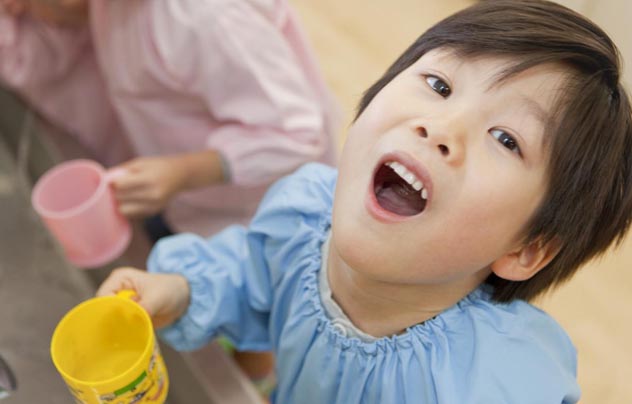
Usually these are drugs such as:
- Penicillin. It is used for streptococcal infection, usually in severe forms.
- Amoxicillin. Children are given injections no more than twice a day.
Antibiotics are used only as directed by your pediatrician or healthcare professional. Treating these drugs yourself is dangerous.
In the event that the reddening of the larynx in a child is caused by streptococcus, complications may occur:
- Rheumatic fever
It occurs when, due to a streptococcal infection, the child's immune system begins to malfunction and, as a result, the body's bacteria and antibodies negatively affect the joints, skin, organs and body systems, including the cardiovascular system.
Despite the fact that this is a rather rare complication, it requires medical intervention if the child has chest pain, difficulty breathing or joint pain. - Glomerulonephritis
A rare complication in which kidney inflammation occurs. With glomerulonephritis, kidney function is impaired, it is characterized by symptoms such as blood in the urine, decreased urine volume when going to the toilet, swelling of the face, feet and ankles.
Pain in the larynx and its inflammation in a child may signal a serious illness or be a symptom of a common cold. If you suspect a streptococcus or a strong allergic reaction, you should consult a doctor, but following the above recommendations, you can successfully treat a child at home.
Useful video about red throat
Parents love to observe the behavior of the child during active games, and always rejoice at his new inventions, enjoy his positive mood and passion. But it also happens: the kid was just laughing cheerfully and rejoicing at his new toy, when suddenly his mood changed, he became lethargic and interest in the game somehow suddenly disappeared. This is how a sudden rise in temperature can affect the child's mood, especially when it is also accompanied by a sore throat. A red throat and a temperature reaching 39 degrees can shock any parent.
In this case, the consultation of a professional doctor is necessary, especially when it is associated with a child. After all elevated temperature and a sore throat, this is most likely a development infectious disease or ARI, and most often viral or bacterial origin... In this case, a jump in temperature can pass as hyperthermia or manifest itself in the form of fever.
Temperature indicator and dynamics of the disease
In accordance with the indicator on the thermometer, you can determine the severity of the development of the disease and its dynamics. That is, if the temperature column has risen to 38 degrees, then in medicine it is considered as a subfebral temperature, which does not require knocking down and shows that the baby's body is actively resisting the penetration of viruses.
With an indicator of 38-40, that is, a febrile temperature, from the word "febris", which means "fever", the intervention of a doctor is required, because this temperature already needs to be brought down, or at least prepared for the fact that the child will need help antipyretic drugs. An indicator of 41 and above indicates immediate assistance from specialists, and often in such cases, children are hospitalized in a hospital. Especially if the high temperature is combined with a reddening of the throat.
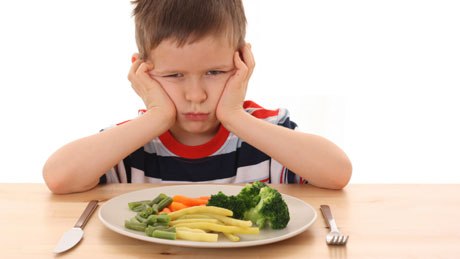 Fever and fever are often accompanied by loss of appetite. Parents make a mistake if they force the child to eat, they say, they need strength. Abundant nutrition can cause a gag reflex, which will aggravate the general condition of the child.
Fever and fever are often accompanied by loss of appetite. Parents make a mistake if they force the child to eat, they say, they need strength. Abundant nutrition can cause a gag reflex, which will aggravate the general condition of the child.
During an illness, a child needs strength first of all so that his body can fight infection, and not digestion. The temperature of 39 ° C also limits the physical activity of children, which in turn also saves energy.
Fever symptoms
But in the case when the throat is red, in addition, the temperature rises to 40, the child may also experience an unpleasant state of fever. How does she manifest herself?
1. At a temperature of 39 and a red throat, the child feels discomfort in the throat, it is difficult for him to swallow food, he has a headache, he is thrown into the cold and then into the heat, and besides that, the whole body aches.
2. There is a loss of fluid, which is necessary not only for the normal functioning of the immune system, but also for the elimination of harmful substances.
3. The need for oxygen increases.
4. Convulsions may occur.
Therefore, first of all, the child needs to provide correct treatment, which is aimed at the source that caused the temperature to rise to 39 and above. However, it must be ensured with plenty of drink. The room where it is located should have a normal humidity level, so you can use humidifiers if necessary. In addition, the room should be well ventilated and cool.
Based on the foregoing, it becomes clear what the first aid is in case the temperature is above 39 and the throat is red. It is possible that the first symptoms that appear indicate the penetration of a bacterial or viral infection. As a rule, after a thorough examination, doctors identify one of the most common diseases that can manifest themselves with such symptoms:
In the case of tonsillitis, the infection settles on the tonsils. After a professional examination of the child's throat, the doctor notes that the tonsils and the throat area are noticeably reddened, while there are no plaques on the tonsils. Cough and runny nose can join such symptoms.
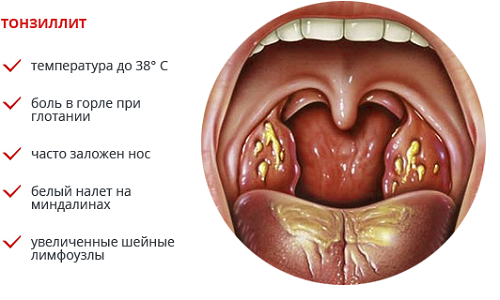 Bacterial tonsillitis is popularly known as sore throat. Angina is characterized by rapid development, in parallel, the body temperature rises to 39 degrees. It hurts the child to swallow, the tonsils are enlarged, and the throat is red. When feeling the nearby lymph nodes, the doctor notes their slight increase and compaction. With angina, a runny nose and cough does not join only if the infection has not spread to the pharynx. There are several types of angina, so only a specialist can prescribe the correct treatment.
Bacterial tonsillitis is popularly known as sore throat. Angina is characterized by rapid development, in parallel, the body temperature rises to 39 degrees. It hurts the child to swallow, the tonsils are enlarged, and the throat is red. When feeling the nearby lymph nodes, the doctor notes their slight increase and compaction. With angina, a runny nose and cough does not join only if the infection has not spread to the pharynx. There are several types of angina, so only a specialist can prescribe the correct treatment.
Scarlet fever
There is also such a disease as scarlet fever, the course of which is also accompanied by angina. In this case, angina in this case acts as a symptom. The pharynx and pharynx of the patient is severely inflamed, there are swelling, high fever, red throat. But, with scarlet fever, you can observe a small rash on the body and symptoms of fever. In this case, for treatment, the doctor must prescribe penicillin antibiotics to the patient.
In the case of pharyngitis, the patient has a combination high temperature and red throat. At the same time, the temperature can go off scale above 38-40 degrees. Viral pharyngitis is usually accompanied by a dry and suffocating cough. Moreover, severe attacks of coughing are especially evident in the morning. 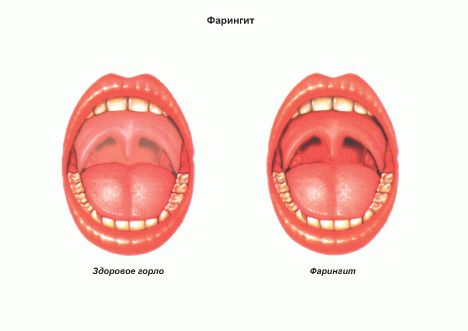
With nasopharyngitis, a runny nose is also added to all of the above symptoms, which must be treated by instilling oil drops. When pharyngitis manifests itself as a symptom of another disease, severe intoxication may be present. For example, with flu or measles. Body temperature rises above 40 degrees.
Hypothermia, dusty air, strong tension in the larynx, as well as alcohol and cigarettes contribute to the development of a disease such as laryngitis. There are two types of laryngitis:
1. Sharp.
2. Chronic.
The onset of laryngitis development occurs suddenly. The patient feels pain when swallowing and a feeling of presence in it foreign body... In this case, the temperature may remain normal or slightly rise. Sometimes with laryngitis, patients complain of headache and cough. Everyone's voice subsides to the point of loss of sound. 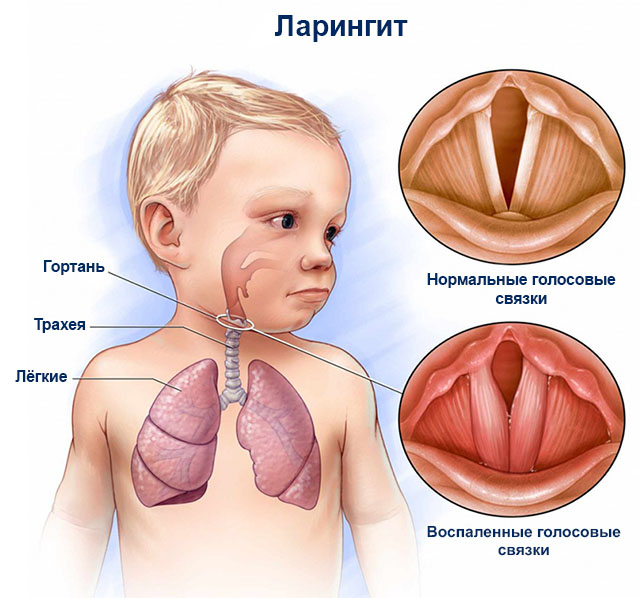
On examination of the larynx, a red throat is observed. It is dangerous that in young children such a disease develops sharply, causing a false croup, that is, swelling of the mucous membrane airways... In especially severe cases, when the air supply is blocked due to lack of oxygen, there is a dysfunction of the brain and the risk of coma.
Undoubtedly, the treatment of such a disease takes place directly in the hospital under the supervision of ENT specialists.
Therefore, each parent should become familiar with the forms of laryngitis and their symptoms. There are the following types of laryngitis:
Atrophic laryngitis.
Professional laryngitis.
Hemorrhagic.
Hypertrophic.
Diphtheria.
Catarrhal.
Laryngotracheitis.
Tuberculous.
So, how to treat a child's red throat, especially when the body temperature exceeds 39 degrees? If the cause of the red throat viral infection, then doctors recommend, in addition to antipyretic drugs:
Gargle a child's throat with decoctions of medicinal herbs,
plentiful drink, preferably vitamin,
oiling eucalyptus, sea buckthorn and rose hips with propolis,
lollipops with mint, lemon or sage (if the baby is over 2 years old).
If the cause of the red throat is sore throat, that is, a bacterial infection, then the child's tonsils may be covered with whitish plaques. In this case, the throat is red, and the temperature rises sharply, up to 40 degrees or more. Most often, throat damage occurs under the influence of bacteria such as streptococci. The child is capricious, becomes nervous and irritable. This is not strange, because angina is always accompanied by painful sensations and an accelerated increase in symptoms. As a rule, treatment is carried out with antibiotics, but only after a medical examination and by his agreement.
Never start treating a sore throat on your own, especially when it comes to a child. Remember that angina is a serious disease that can be easily treated, but with inadequate treatment, angina can cause serious complications.
Solution sea \u200b\u200bsalt,
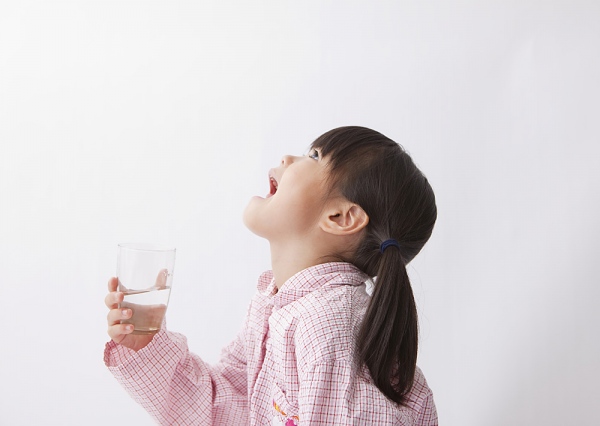
decoctions of medicinal herbs,
green tea with added salt,
soda solution
propolis solution,
carrot or beet juice,
diluted lemon juice.
Also, such medications like Furacilin, Malavit, Miramistin.
With the right treatment, a symptom such as a red throat can be easily cured. Therefore, without fail, show the child to a doctor who will help you establish the true cause of such a symptom and offer the right drugs that will alleviate the baby's condition in a short time.
Fever symptoms
And, finally, let us once again recall the symptoms of fever in children. If your baby is still small, then he can frolic even when his temperature is already rising. At the same time, he becomes less active, often sits down to rest. And at that time, the disease was already in full swing. Therefore, parents should correctly assess the condition of their baby.
If the child refuses to eat, and you notice signs of lethargy, then you can already suspect the onset of the disease. Babies react to a rise in temperature in a peculiar way - they can cry for no reason, turn away from their breasts during feeding, nervously wave their hands and wriggle their bodies.
If you have such symptoms, you should make sure that it is within the normal range. If the indicator on the thermometer reaches 39, which often happens with angina, first of all, try to give the baby a drink and call a doctor.
If the temperature indicator is within the nome, then it is worth rechecking its condition in an hour.
Do not bring down the temperature, which does not exceed 38.5, because the body intensively produces interferon necessary to fight the virus.
But if at such a temperature the child has convulsions or other suspicious phenomena, then it is even necessary to knock it down, and even better, immediately call an ambulance.
Remember that in children under the age of three, a temperature of 37.5 is considered normal, so you should not panic prematurely. This is just a suspicion of a disease. Therefore, make sure that the baby does not have a runny nose, and when examining the throat, there is no redness.
